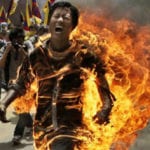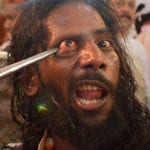 Politics
Politics  Politics
Politics  Weird Stuff
Weird Stuff 10 Freaky Times When Famous Body Parts Were Stolen
 Miscellaneous
Miscellaneous 10 Interesting Things Manufacturers Stopped Making and Why
 Gaming
Gaming 10 Funny Tutorials in Games
 History
History 10 Fascinating Little-Known Events in Mexican History
 Facts
Facts 10 Things You May Not Know about the Statue of Liberty
 Movies and TV
Movies and TV 10 Movie Adaptions That Brought Popular Songs to Life
 Health
Health 10 Miraculous Advances Toward Curing Incurable Diseases
 Miscellaneous
Miscellaneous 10 Undeniable Signs That People’s Views of Mushrooms Are Changing
 Animals
Animals 10 Strange Attempts to Smuggle Animals
 Politics
Politics 10 Countries Where Religion and Politics Are Inseparable
 Weird Stuff
Weird Stuff 10 Freaky Times When Famous Body Parts Were Stolen
 Miscellaneous
Miscellaneous 10 Interesting Things Manufacturers Stopped Making and Why
Who's Behind Listverse?

Jamie Frater
Head Editor
Jamie founded Listverse due to an insatiable desire to share fascinating, obscure, and bizarre facts. He has been a guest speaker on numerous national radio and television stations and is a five time published author.
More About Us Gaming
Gaming 10 Funny Tutorials in Games
 History
History 10 Fascinating Little-Known Events in Mexican History
 Facts
Facts 10 Things You May Not Know about the Statue of Liberty
 Movies and TV
Movies and TV 10 Movie Adaptions That Brought Popular Songs to Life
 Health
Health 10 Miraculous Advances Toward Curing Incurable Diseases
 Miscellaneous
Miscellaneous 10 Undeniable Signs That People’s Views of Mushrooms Are Changing
 Animals
Animals 10 Strange Attempts to Smuggle Animals
10 Pious People Who Defy Common Religious Stereotypes
Stereotypes have a nifty way of condensing oceanic amounts of information about people into neat, bite-sized parcels. They’re also quintessential conduits for discrimination and cultural misrepresentation. Few domains exemplify this danger better than religion. Sweeping generalizations about what people of differing faiths are like can create the impression that a Christian, Muslim, or Jew, for example, can be reductively summed up by traits ranging from shrewd huckster to misogynistic terrorist. And while everyone can point to a real-life exemplar that bears some semblance to a crude generalization, to every overly broad rule there are glaring exceptions. For example . . .
10Nuns With Guns

American pop culture regularly portrays nuns as women who serve their church, slap disobedient Sunday school children with rulers, and lead otherwise uneventfully chaste lives while clad in glorified penguin costumes. But many modern nuns have given the Vatican an ulcer’s worth of stress with progressive views that flout church traditions. And far from leading painfully dull existences, some have even hit the mean streets, seeking out would-be evildoers in the name of justice. Take, for example, Sister Mary Cornelia—or, as her fellow police officers called her, “Sister Fuzz.”
Sister Fuzz worked with the Pontoon Beach, Illinois, police department in the 1970s and was a collection of visual contradictions. Like nuns depicted on the big screen, she wore a habit and taught Sunday school. But she also investigated juvenile narcotics cases, used handcuffs, and carried a .38-caliber revolver for striking down sinners who might dare to trespass against her. She was also trained in judo and karate. But even more striking than the thought of a karate-chopping nun is that Sister Cornelia wasn’t the only law enforcer ever to boast a halo. That brings us to Sister Sally McCarthy, whose many talents even outshine her supremely catchy nickname, the “God Squad.”
Sister McCarthy couldn’t brag about being a pistol-packing judo expert, but the Florida officer did once pursue a pumpkin vandal and frisk a drug offender. Far more impressively, she was a Jackie of all trades who used her wealth of talents to benefit humanity. In addition to arresting criminals, she was a nurse trained to assist in open-heart surgery, a social services counselor, a detective of police and fire investigations, the first female president of the DuPage County Juvenile Officers Association, a crisis team member, and a recipient of master’s degrees in both clinical social work and psychology. In short, McCarthy was a one-woman army of public service who also knew her way around a convent.
9Miss Muslimah, The Islamic Equivalent Of Miss World
Pinning down the beliefs of Islam’s 1.6 billion adherents as a single set of generalizations would be like trying to describe every flavor of ice cream in existence as chocolate. Yet in major Western nations like the US, Germany, and the United Kingdom, majority-Muslim countries are often discussed as monolithic hotbeds of terrorism and unwavering misogyny. The stereotypical Muslim woman is generally thought to be the victim of a thoroughly oppressive system that denies her basic freedoms, depreciates her as a person, and hides her face and body under suffocating burquas. So it might come as a surprise to some that the most Muslim-populated nation hosts the religious equivalent of a beauty pageant.
That pageant is the World Muslimah Award—commonly referred to as Miss Muslimah. First organized in 2011, the competition is held in Indonesia and attracts Muslim women from around the globe. The goal of Miss Muslimah is to find the cream of the Islamic crop. To win, contestants must complete a battery of religion-related tasks, including reciting passages from the Quran, performing 2:00 AM prayers, and visiting the poor and elderly. Even so, Miss Muslimah is also a glamorous affair often marketed as an Islamic spin on Miss World and for good reason.
Contestants wear stylish, vividly colored attire, and their shoes sport a noticeable heel. Their faces are covered only by carefully applied layers of makeup, allowed to bask in the attention of admiring eyes. This emphasis on spectacle undoubtedly relates to the origins of the competition. Miss Muslimah was founded as a celebration of Islamic fashion by former Indonesian TV presenter Eka Shanty after she was fired from her job for refusing to remove her head hijab. It later blossomed into a celebration of Muslim women.
As the event has matured, it has also acquired a more socially conscientious significance as aspiring pageant winners vie for more than recognition as model Muslims. Several promote such goals as improving educational opportunities and achieving greater gender equality for Muslim women who suffer under more oppressive interpretations of Islam.
8Muslim Punk Rockers
News stories about Muslim parents withdrawing their children from school-mandated music classes and Taliban extremists beheading people for singing and dancing can advance the narrative that the majority of Muslims hold views starkly incompatible with Western society. It’s far too easy for those already inundated by stories about Muslim othernerness to get the impression that people who embrace Muslim beliefs typically reject Western music at the very least. But in countries like the United States, a contingent of Mohawk-wearing Muslims has challenged that perception with the power of punk rock.
Their members have included atheists and practicing Muslims. Their cultural and religious roots lie in countries like Pakistan and Indonesia. They employ an eclectic mix of South Asian musical sounds and punk rock, striking both chords and nerves with provocative songs like “Sharia Law in the USA” and “Suicide Bomb the GAP.” They are Muslim punk bands, and their unique blend of musical themes and styles is popularly known as Taqwacore. Much like their lives, the bands’ music often paints a picture of tension between the American culture that often pigeonholes or rejects them and the Islamic traditions they have inherited but in some cases disavow.
Although Muslim punk rockers such as controversial British band Alien Kulture precede Taqwacore by decades, the idea of an actual Muslim punk music community didn’t gain traction until introduced by the 2003 fiction novel Taqwacore. This book captured the imaginations of young Muslims, leading to what would become the Taqwacore scene. However, despite this historical separation, the Muslim punk rockers of the present day share an important commonality with their British musical predecessors. When Alien Kulture emerged in 1979, it ruffled the feathers of Westerners by criticizing xenophobic prejudices and angered conservative Muslims by attacking such controversial practices as arranged marriages. Similarly, Taqwacore musicians straddle a cultural intersection from which they rebel against the conservative elements of their religion while lashing out at against Western misconceptions.
7Neon Trees, The All-Mormon Rock Band With A Gay Lead Singer
Although Mormons only made up a scant 1.7 percent of the US adult population in 2007, the presidential pursuits of former governor Mitt Romney propelled them to national prominence. Polling data indicates that Mormons by and large are deeply devout and extremely conservative. That account fits perfectly with the antiseptic demeanor and equally clean-cut shirt-and-tie combo we associate with Mormon missionaries. But in recent years, Americans have caught on to the existence of a colorful counterpart to the rice-cake-like wholesomeness we’ve come to expect from the Church of Jesus Christ of Latter-day Saints (LDS): a flashy pop-rock band called Neon Trees.
A throwback to 1980s music, the four-person band regales its fans with upbeat melodies as they vaunt bleached-blond hair and peacock-worthy clothing choices. They got their start, appropriately enough, in the dry community of Provo, Utah, before making it to the big time. The idea of Mormons pursuing a full-fledged career in rock music, which is often associated with lifestyles of unfettered debauchery, is odd enough. But then in 2014, Neon Trees front man Tyler Glenn revealed to the world that he’s gay.
The apparent conflict was undeniable. Glenn had often seen himself in the role of religious celebrity, and the band was famous for its religiosity. Neon Trees drummer Elaine Bradley had even done PR work for the LDS. Glenn’s homosexuality sounded entirely inconsistent with a band so steeped in such a traditionally conservative faith. But just as Neon Trees has stood out as an unexpected face of Mormonism, so too has the Church’s general reaction to Glenn’s sexual orientation.
Many people, including Tyler Glenn himself, expected his revelation to be met with mostly harsh rebukes from LDS authorities. Instead, he received plenty of encouraging responses from LDS leaders praising his decision to come out. As it turned out, plenty of folks (even a practicing Mormon) had significantly underestimated Mormons’ capacity for openness.
6New Zealand’s Comically Irreverent St. Matthew-In-The-City Church
In 2009, mere days before Christmas, some of Auckland, New Zealand’s Christian population was shocked to the point of indignation by a religious billboard. It featured biblical titans Mary and Joseph lying forlornly in bed. Joseph stared limply into the distance, red-cheeked and seemingly embarrassed. Mary turned away from her husband with icily displeased eyes. The caption scrawled above their glum heads told the whole story: “Poor Joseph. God was a hard act to follow.” Some bold and arguably blasphemous jokester had hinted that the Almighty had physically (and perhaps sexually) impregnated the mother of Jesus, leaving an obviously outmatched Joseph to flounder in carnal matters thereafter.
St. Matthew-in-the-City Church was the decidedly unapologetic culprit. According to the church vicar, Archdeacon Glynn Cardy, the billboard was intended as food for thought. The vicar felt that too many people obsessed over literal interpretations of Christ’s conception. By laughing at the bizarre implications of that literality, St. Matthew-in-the-City hoped people would think less about Christ’s birth and more about His love for humanity. Whether the undertaking was ultimately successful is anyone’s guess, but the tactic of using racy humor to raise deeper theological questions became a consistent pattern nonetheless.
In 2012, the church outed itself as a proponent of same-sex marriage with a billboard of two women in wedding dresses locking lips atop a wedding cake, along with an unsubtly sexual pastry pun: “We don’t care who’s on top.” In December that year, the church punctuated their position with a billboard displaying a rainbow-encircled baby Jesus and the text: “It’s Christmas. Time for Jesus to come out of the closet.” In doing so, St. Matthew-in-the-City sought to make onlookers assess their own views on homosexuality, pointing out that Christ’s sexuality was never specified in scripture, and, more importantly, that it shouldn’t matter.
5JC’s Girls Stripper Outreach Ministry
American Christian conservatives are famous for adopting hard-line stances against sex and sexual freedom as part of a long-standing cultural war. Fire-and-brimstone condemnations of pornography and promiscuity by conservative icons like the Reverend Jerry Falwell have left an indelible mark on Christianity’s image. Present-day groups like the Family Research Council continue that legacy when they advocate denying university students access to porn. It was unsurprising when in 2014 a church went to war with a strip club. But others who adopt the Christian mantle reject such prudishness and in some cases are the very sorts of individuals conservative Christians abhor.
Heather Veitch is the founder of the JC’s Girls outreach ministry, which brings Christianity to the world of stripping. Veitch’s story is one of pain, perseverance, and inspiration. After being raped when she was 14, Veitch led a life hypersexual exploits, stripping, and soft-core pornography. She eventually embraced Christianity, married, and settled down. Then misfortune struck anew. A good friend of Veitch who had worked as a stripper died tragically, unable to escape her personal demons. Moved by the loss, Veitch embarked on a mission to share the Christian faith that helped her turn her life around with women in the sex industry.
With help and encouragement of a California pastor, Veitch founded the JC’s Girls ministry, which quickly garnered attention for its immodest style. Its members conducted their work by going to strip clubs and arranging for private lap dance sessions which they instead used for evangelism. Their website dripped with self-aware sex appeal. Veitch, referred to by the 700 Club’s Pat Robertson as the “holy hottie,” distributed hundreds of bibles wrapped in “Holy Hottie” T-shirts alongside fellow JC’s girls at America’s largest sex trade show. Though seemingly outlandish in its methods, the ministry was driven by a loving, tolerant aim: not to reform or fix people in the sex industry but to extend a hand in the name of faith.
4Alysa Stanton, America’s First Black Female Rabbi
Among the most easily recognized Jewish motifs is that of the rabbi. As mainstream movies like A Serious Man and classic sitcoms like Seinfeld will attest, the archetypal rabbi is a stuffy white male who wears a wide-brimmed hat (or alternatively a yarmulke) and speaks in aphorisms. A discussion about the kinds of people who become rabbis wouldn’t immediately bring to mind Alysa Stanton, who holds the distinction of being America’s first female rabbi of African-American heritage.
Alysa Stanton didn’t grow up with dreams of being a rabbinical trailblazer. She was born to a Pentecostal family and in her youth dabbled in various religions in a search of a spiritual niche. When her family relocated to a largely Jewish suburb in Cleveland, Ohio, she finally found her calling with Judaism. And after enjoying a career as a grief counselor and psychotherapist, Stanton answered her call by enrolling at the Hebrew Union College to undergo rabbinical training. She studied for seven years, successfully graduated, and in 2009 became the first black female rabbi in American history. She then made headlines acquiring a rabbinate with the predominantly white Bayt Shalom congregation of Greenville, North Carolina.
Stanton’s journey was tough. She faced strong opposition from more conservative Jews uncomfortable with her aspirations. As a black single mother who had officially converted to the faith in adulthood, she didn’t fit the mold. Stanton’s story of hard-won success didn’t end on an entirely happy note. Her North Carolina congregation opted not to renew her two-year contract after it expired, saying she wasn’t a “good fit.”
3Christians Fight Ministries
Since the 1930s, the Gallup Poll has consistently observed that men are far less enthusiastic about attending church than women. While Gallup tried to explain the trend in terms of how differing gender roles made church differentially appealing to men and women, outspoken figures like David Murrow have attributed this phenomenon to the “feminization” of American church services, which allegedly stifle manly urges with their warm, family-friendly atmosphere. In keeping with that ethos, pastors throughout the United States have founded what are known as Christian fight ministries, which pique male interest by training them in UFC-style cage fighting.
Fight ministries are an outgrowth of the burgeoning popularity of Ultimate Fighting Championship (UFC) events. Pastors rationalize the union of combat sports and communion with such biblical excerpts as “fight the good fight of faith” from the Book of Timothy. However, one need only reflect on such famous Christian teachings as “turn the other cheek” and “love thy neighbor” to hear how discordant a pairing of prayer and face-pummeling sounds. Nonetheless, that pairing clearly sounded like sweet music for the men who joined organizations like Nashville’s nondenominational Xtreme Ministries to receive guidance on how to lead a good life and cave a man’s face in with a right hook.
For some of these church gladiators, organized violence has taken on both metaphorical and practical meanings. Former gang member and church convert Mike Thompson described his fight ministry as an opportunity to care for his family, as being a paid fighter gave his life renewed purpose. But perspectives like Thompson’s aren’t shared by everyone. Some pastors at more traditional houses of worship argue that using combat to recruit members threatens to eclipse the religious aspect the ministry. Nonetheless, fight churches have amassed a sizable following, with an estimated 700 such organizations operating in the United States as of 2010.
2Yossi Eilfort, The Martial Arts Rabbi
Christian fight ministries haven’t entirely cornered the market on incongruous aggression. In 2014, a young rabbi out of San Diego stepped into a UFC cage to square off against an opponent. It was undoubtedly an unusual scene. Not only are the religious not thought of as violent people, but the reality of a rabbi engaged in competitive fighting also bucked the age-old Hollywood depiction of Jews as frail, athletically challenged people. But the unlikely fighter, Yossi Eilfort, wasn’t just athletic—he was skilled. Eilfort bested his foe within two rounds of competition, becoming a minor celebrity in the process.
Eilfort’s faith wasn’t the only thing that made his bout unusual. The rabbi actually abhors violence and has avoided it for most of his life. In fact, he even admitted to holding back during his fight to avoid unduly injuring his opponent. Rather, as a skilled martial artist who spent years training in various combat styles without ever getting into a fight, he wanted to demonstrate for fellow Jews that virtuousness doesn’t preclude a life of competitive activities such as martial arts training.
While Rabbi Eilfort’s aim was to embrace athleticism over brute pugilism, that doesn’t mean he’s unconditionally committed to pacifism. An advocate of conflict preparedness, Eilfort has offered self-defense seminars and is a competitive marksman. So while he probably wouldn’t go out of his way to harm a fly, he’ll certainly be able to pluck its wings should the need arise.
1Father Gofo, The Rock-And-Roll Priest
Depictions of the priesthood normally veer in one of two directions: toward an image of uptight goodie-goodies with cardboard-bland personalities or toward a minefield of sex scandals, corruption, and toxic hypocrisy. But Mexico’s Adolfo Huerta Aleman, also known as “Father Gofo,” doesn’t fall into either of those camps, instead painting the picture of a religious rebel with a cause. Father Gofo rides a motorcycle, listens to rock music, smokes, drinks, and isn’t ashamed to look at photos of nude women. And on Sundays, he dons priestly robes, stands before a gathering of the faithful, and instructs them on how to reserve a spot in eternal paradise.
For Aleman, the clashing personas of rebellious biker and holy man aren’t remotely problematic. Rather, the cleric describes his brand of faith as an “adult” one that acknowledges the rougher aspects of the human condition. He has even publicly expressed indifference as to whether God exists. Whereas others devote their efforts to communicating with a higher power, Father Gofo is more inclined to place his faith in human relationships. To Aleman, “There is more communion at barbecues, at parties, at bars. When you arrive at those gatherings and places, people greet you, they hug you, they ask you how have you been. When you arrive at church, nobody notices each other and they only shake hands when the priest tells them to do so.”
Aleman first and foremost uses religion as a platform to help the disadvantaged. As a man who spent his young adulthood working with HIV-patients and prostitutes, he is no stranger to the more marginalized members of society. Now, as a priest, Aleman champions victims of drug trafficking and members of the LGBT community. He ventures into dangerous neighborhoods where few clergymen would feel comfortable in hopes of winning over new souls. His long hair, edgy attire, and rock-and-roll attitude help him to fit in with rougher crowds. But Father Gofo’s not interested in wagging self-righteous fingers or warning against damnation. His flock subsists in those who need saving from society.








